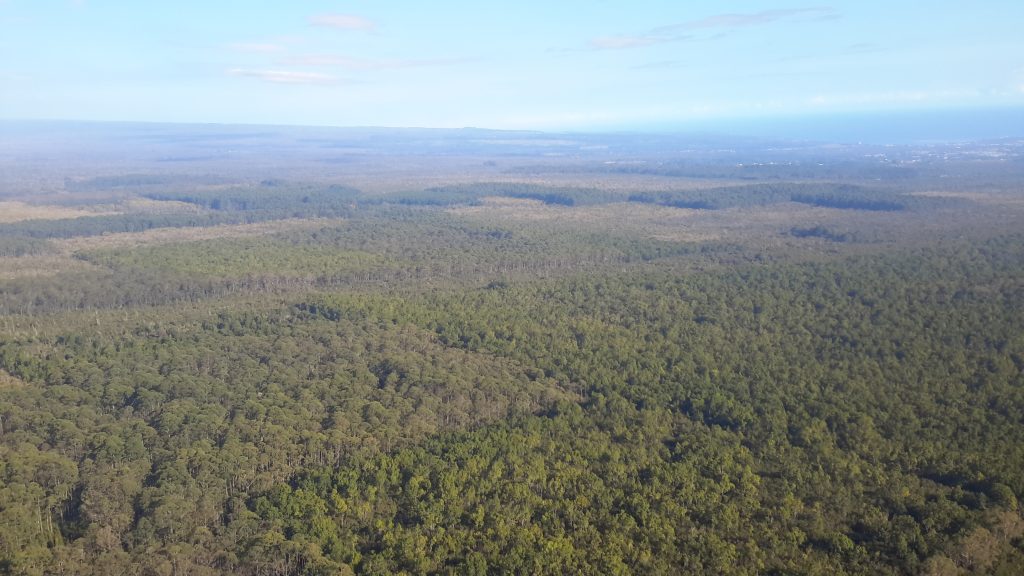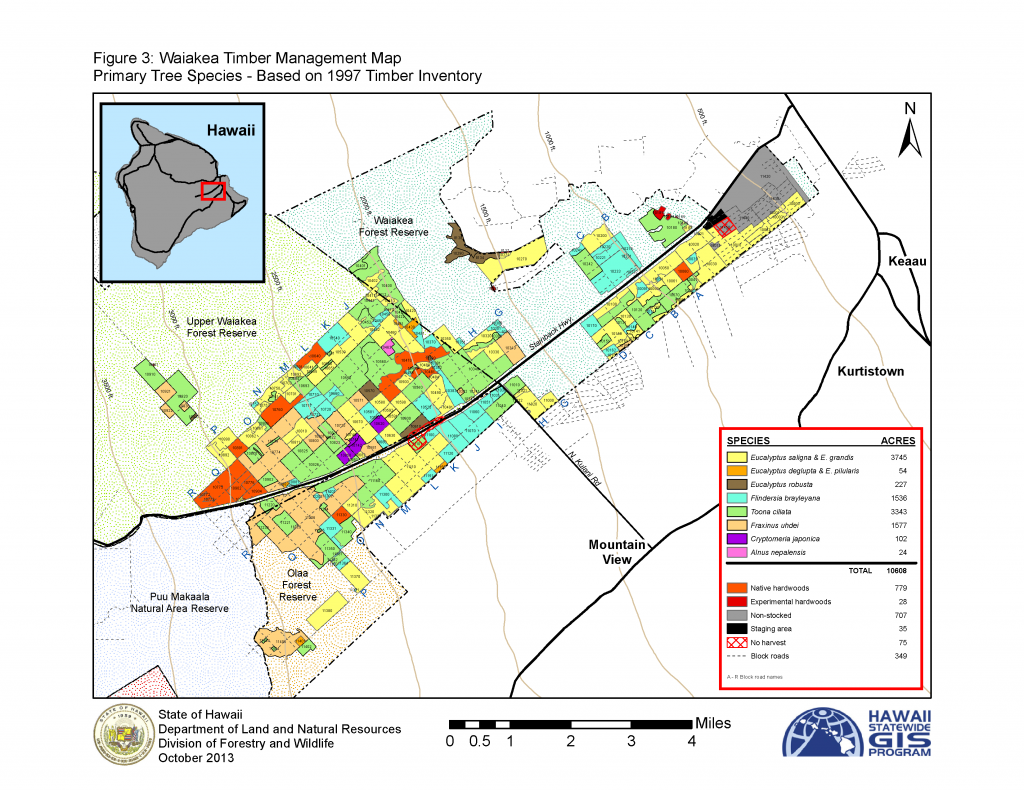Waiākea Timber Management Area
Located on the northeast slopes of Mauna Loa, the Waiākea Timber Management Area (WTMA) is approximately 12,506 acres and is composed of non-native hardwood plantations that were planted with intent for commercial harvesting. The area is approximately five miles southwest of Hilo town and highly accessible along the Stainback Highway spanning over portions of Upper Waiākea, Waiākea, and ‘Ōla‘a Forest Reserves. WTMA was established to provide a consistent wood supply to support the development of a forest products industry in Hawai’i. Major planting efforts began in 1959 and by 1997, timber inventory data indicated that the WTMA contained approximately 17 million cubic feet of gross merchantable timber. Predominant timber species of WTMA include Queensland Maple (Flindersia brayleyana), Eucalyptus saligna and grandis, Australian toon (Toona ciliate), and Tropical ash (Fraxinus uhdei).
Guiding Principles
- The State should utilize its land and timber within the WTMA to maximize local processing where feasible, create jobs, and encourage development of integrated processing facilities that provide suitable outlets for the range of species and grades of wood that currently exist. DOFAW should also look at current market and future demand projections, to help decide what will be the most valuable and in demand timber to replant.
- Effective soil erosion control practices, including harvesting methods and replanting; safe use of herbicides; and visual buffers along major transportation corridors will be required for all commercial forest operations within the WTMA as outlined in the State’s Best Management Practices.
- The State will not replant non-native invasive species with a score rating of seven or higher on the Hawaii Weed Risk Assessment within the WTMA. Further, the State will evaluate all non-native species proposed for planting in the WTMA for their potential invasiveness if they have not been evaluated through the Hawaii Weed Risk Assessment. All species currently in the WTMA have the option of being replanted.
- The need to involve the public in project planning and development is important to account for the appropriate use of the resources, especially when it affects local communities. Careful integration of timber management with hunting, recreational and gathering activities will aid in developing community support for growing and processing timber resources.
- A portion of the timber within the WTMA should be reserved to supply local entrepreneurs and small businesses, thus increasing community recognition regarding the economic opportunities offered by sustainable forest management. This reservation percentage will be based on the amount of local demand. The higher value timber within the WTMA can provide wood needed to take advantage of new forest marketing programs to stimulate the creation of niche market for locally grown woods. Portions of the WTMA should also be used for the development of non-timber forest products.
- The public forest estate in Hawai‘i (11th largest in the U.S.) has a low level of public investment (e.g. one forester per 150,000 acres of public forest reserve on the Island of Hawai‘i). This investment is not expected to increase significantly with the current fiscal situation in Hawai‘i. In order to manage the WTMA sustainably, a portion of the timber proceeds should be reinvested back into the forest.
- Timber management and research activities in the WTMA can provide a valuable educational role in extension and training, contributing practical information to both the government and private sectors while helping create a professional forestry work force. Portions of the forest can be used as an outdoor laboratory for the forestry curriculum for various colleges within the University of Hawai‘i system.
- There will be no timber harvesting, forest clearing, or other commercial timber operations within designated native forest sections of the WTMA. Special harvesting permits for the cultural gathering of native species may be granted.
Timber Inventory
In 1997, a timber inventory was conducted to obtain information on tree species size and density as well as timber species volume in the area.
| Primary Tree Species |
Acreage |
Total Merchantable Volume |
| Flindersia brayleyana | 1,536 | 2,539,213 |
| Eucalyptus saligna and grandis | 3,745 | 8,176,042 |
| Eucalyptus robusta | 227 | 1,007,433 |
| Eucalyptus deglupta and pilularis | 54 | 88,711 |
| Toona ciliata | 3,343 | 2,588,887 |
| Fraxinus uhdei | 1,577 | 863,971 |
| Alnus nepalensis | 24 | 110,855 |
Benefits
WTMA has an estimated economic stumpage value of several million dollars. The actual revenue depends on the markets currently available for the timber resources. The value-added economic gain to the local economy is estimated to be greater than the actual stumpage value, by providing:
- Stimulation of the forest product industry in Hawai‘i
- Creation of jobs for the local community
- Gain to the local economy
- Local source for wood products
- Energy security as a source of biomass and biofuel
In addition to commercial timber resources, the WTMA also provides several important public uses such as:
- Recreation
- Gathering
- Hunting
- Habitat for native biodiversity and watershed protection
Previous Licenses
The state has previously had timber licenses for the WTMA including:
- Timber harvest agreement with the Puna Sugar Company from 1985-1988, seeking approximately 2,000 acres of Eucalyptus.
- From 2001-2011, approximately 68% of WTMA was under a timber land agreement with Tradewinds Forest Products.
- From 2007-2015, approximately 1,000 acres of WTMA were under timber land license.
Overall, little to no harvesting occurred at the WTMA with exception of small-scale timber salvage operations.
Future Plans
In its meeting on February 26, 2016, the Board of Land and Natural Resources approved DOFAW’s plans to issue a request for information (RFI) to assess the interest of the forest industry market followed by a request for proposals (RFP) for the potential issuance of new timber land license(s) in WTMA. Agenda, submittals, and minutes of this and other meetings can be found on the BLNR’s websites.



